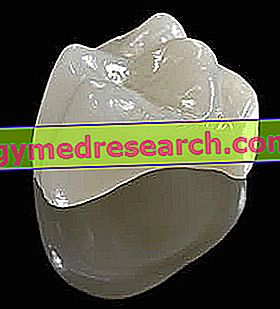What is a Dental Capsule?
The term "capsule" is used in the dental field to indicate an artificial dental crown (also defined as "prosthetic crown"), consisting of an extremely resistant metallic heart and a glossy resin or ceramic coating.

Indications
When is the use of the Dental Capsule indicated?
The dental capsule is indicated in the following circumstances:
- The tooth is affected by extensive and deep caries, and cannot be restored by simple filling.
- The tooth is seriously compromised by dental pulp (pulpitis) infections.
- The tooth is chipped, broken or seriously damaged: in such circumstances it is necessary to intervene to improve the aesthetics of the smile.
- The tooth is extremely fragile and subject to breakage.
- The tooth enamel was severely and irreparably damaged.
- The tooth has been devitalized and requires a new artificial crown.
- Cover a dental implant.
- Dental diseases that lead to the progressive exfoliation of dental enamel.
Application
Before proceeding with dental encapsulation, it is necessary to remove the natural crown of the damaged tooth - the portion of the tooth that protrudes from the alveolus - in order to create the appropriate space to insert the dental capsule.

- After removing the damaged natural crown with special cutters, the dentist makes a dental impression: from the patient's dental cast a model of the tooth is obtained which, sent to the laboratory, will then be used to perfectly build the size of the capsule.
- Subsequently, the patient is applied a temporary dental capsule, composed of acrylic resin (waiting for the definitive capsule to be built in the laboratory by the dental technician).
- Before completing the (final) dental capsule, the patient is called to the dental office to evaluate, together with the doctor, the shape and color of the new crown. The capsule, in fact, must have the same shape as the crown removed and the same color as the other teeth. Just to give an example, it would not make sense to insert a white and shiny dental capsule on yellow teeth or a color more charged than the much sought-after whiteness. The ideal tonality of the capsule is decided together with the dentist, using the aid of a standard colorimetric scale that will serve as a model. Alternatively, dental staining can be measured using a special spectrophotometer.
- Once ready, the capsule must be tested directly in the patient, so that it can possibly be retouched or modified before being permanently fixed.
- When perfectly defined and modified, the capsule can be cemented into the tooth.
Did you know that ...
The teeth of each individual have their own and characteristic color that does not necessarily correspond to the white and luminous white that is constantly present in many advertisements for products intended for the care and cleaning of teeth (toothpastes, bleaching pens, mouthwashes, etc.).

For this reason, it is completely useless to expect the creation of absolutely white "advertising" capsules, since the result in these cases would be decidedly unaesthetic.
In this regard, it should be emphasized that, in these cases, it is always good to hear the opinion of the dentist and dental technician who - being professionals of the trade - will certainly be able to advise the patient in the best way.
Capsule Materials and Types
A dental capsule can be made of different materials, depending on the case and the different needs of each patient.
Depending on the materials used, it is possible to distinguish different types of capsules which will be briefly described below.
Metal-ceramic dental capsule
The metal-ceramic dental capsule is composed of two sections: an extremely solid and resistant internal metal reinforcement, and an external coating that can be composed of different materials.
In detail, a dental capsule of this type consists of:
- A soul - whose function is to offer a certain solidity and resistance to the tooth - made up of precious metal alloys (based on gold or platinum ) or less precious alloys, such as those in chromium- chelate .
- An outer shell made entirely of ceramic ( feldspar ceramic). The function of the lining of the capsule is twofold: to give an excellent aesthetic to the tooth and to ensure a resistant and solid chewing surface, comparable to that of natural dental enamel.
Metal-free ceramic dental capsule
A metal-free ceramic dental capsule is a particular type of prosthesis completely devoid of the metal component. This type of capsule makes it possible to obtain better aesthetic results than those in metal-ceramic.
In turn, the metal-free ceramic capsules are divided into:
- All-ceramic capsules, mostly composed of lithium disilicate;
- Zirconium-ceramic capsules, composed of a rigid core of zirconium oxide, an innovative material with surprising resistance and aesthetics, combined with an external part made of ceramic.
Metal composite dental capsule
The matallo-composite dental capsules consist of a metal core and a composite resin coating.
This type of capsule is generally not used in dental encapsulations, but in implantology, but it will not be discussed in this article.
Other types of dental capsules
In addition to those described so far, there are also other types of dental capsules. Among these we find the metal-resin capsules . An example of this type of prosthesis is represented by the capsules composed of a combination of gold and resin, in which the chewing part is entirely made of gold; while the aesthetic part (dental facet) is made of resin.
Another type of dental capsule is made entirely of metal, usually in gold.
However, both of these types of capsules are obsolete and are no longer used.
Finally, there are also capsules composed entirely of resin, the use of which is mostly reserved for temporary crowns.
Results
The success of the realization of a dental capsule depends above all on the skill of the dentist in determining the correct coloring of the patient's teeth and, subsequently, from the mastery of the dental technician in recreating the same color, as well as the characteristic lines of the tooth to be encapsulated .
More precisely, the dental technician will not only have to recreate the proportions and shapes of the tooth to be encapsulated, but will have to customize the capsule in order to adapt it to the dental physiognomy of each individual patient.
If the dentist and dental technician collaborate and work correctly, the final results will certainly be excellent and the patient will certainly be satisfied with the work. A well-made capsule, in fact, will go unnoticed and nobody will realize that the crown of the natural tooth has been replaced with a dental prosthesis.
Disadvantages
Fortunately, the disadvantages of dental capsules are not many.
A first disadvantage is the hardness of the dental capsule. In fact, these prostheses can break or chip more easily than a natural tooth. For this reason, it is advisable to avoid or at least limit the intake of crunchy and hard foods such as nougat, dried fruit or hard candy. In case of breakage or loss of the capsule (however remote event) it is necessary to contact the dentist as soon as possible, who will provide for a re-reception of the same.
Cost of a dentele capsule
The second disadvantage, however, is the cost of the prosthesis in question. Remaining in the field of dental encapsulation, in fact, the price of applying a capsule generally exceeds 400-500 euros .
However, we recall that a metal-ceramic dental capsule normally costs less than metal-free ceramic capsules.
As for the application of a dental capsule in implantology, instead, the price will be much higher, since the cost of the implant (about 1, 000 euros) will have to be added to the cost of the single dental capsule (400-550 euros).
Precisely with regard to the high costs of applying a dental capsule, it is important to remember how important it is to apply only and exclusively to specialized doctors and professionals in the sector, without being deceived by those who offer treatments at excessively low prices, since they can potentially expose to serious health risks (development of infections, contraction of pathologies, damage to the encapsulated tooth, etc.).
Care
Useful tips for the care of the Dental Capsule
Similar to natural teeth, capsules also require careful dental hygiene. The encapsulated tooth must be brushed and cleaned just like a natural tooth:
- Brush your teeth with toothpaste and brush three times a day and after each snack
- Watch out for toothpastes that are too aggressive for tooth enamel
- Limit your intake of coffee, tea and chocolate (useful to keep your teeth white and prevent stains on your teeth)
- Use dental floss at least once a day
- Not smoking
- Daily dental hygiene must be supported by professional dental cleaning (scaling) once or twice a year
Conclusions
To conclude, let us remember that even an encapsulated tooth can be carious: plaque and tartar can accumulate on the gum line, creating periodontal diseases (eg pyorrhea) and cariogenic processes such as to require dental intervention.
Dental capsules require periodic and specific checks every 6-12 months.



